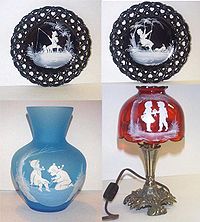
Mary Gregory
Encyclopedia

United States
The United States of America is a federal constitutional republic comprising fifty states and a federal district...
glass painter at the Boston and Sandwich Glass Company
Boston and Sandwich Glass Company
The Boston and Sandwich Glass Company was incorporated in 1826 to hold the glass factory built a year earlier in Sandwich, Massachusetts, by Deming Jarves. The factory was closed in 1888 amid disputes with the newly formed glassmaker's labor union....
in Cape Cod, Massachusetts who helped popularize glass-painting.
Victorian children
She was particularly well-known for her paintings of Victorian EraVictorian era
The Victorian era of British history was the period of Queen Victoria's reign from 20 June 1837 until her death on 22 January 1901. It was a long period of peace, prosperity, refined sensibilities and national self-confidence...
children, and such artwork has been referred to as Mary Gregory since the 1920s. However, it was shown that such artworks were actually from an earlier era, and the term was likely the result of marketing by the Westmoreland Glass Company. The glass most likely came from Bohemia
Bohemia
Bohemia is a historical region in central Europe, occupying the western two-thirds of the traditional Czech Lands. It is located in the contemporary Czech Republic with its capital in Prague...
, England
England
England is a country that is part of the United Kingdom. It shares land borders with Scotland to the north and Wales to the west; the Irish Sea is to the north west, the Celtic Sea to the south west, with the North Sea to the east and the English Channel to the south separating it from continental...
, or Italy
Italy
Italy , officially the Italian Republic languages]] under the European Charter for Regional or Minority Languages. In each of these, Italy's official name is as follows:;;;;;;;;), is a unitary parliamentary republic in South-Central Europe. To the north it borders France, Switzerland, Austria and...
. Despite this, many glass art enthusiasts continue to refer to such pieces as Mary Gregory.
Westmoreland Glass Company
The Westmoreland Glass Company of Grapeville, PennsylvaniaGrapeville, Pennsylvania
Grapeville is a census-designated place in Hempfield Township, Westmoreland County, Pennsylvania, United States. The population was 676 at the 2000 census.-Geography:Grapeville is located at ....
began marketing their glasswork as Mary Gregory in the 1920s. They would create glass paintings of Victorian Era children in profile, and say it was done in the style of Mary Gregory. Westmoreland artists painted the cherubic white silhouettes on black milk glass plates, vases, glass boxes, heart-shaped plates, et cetera. In the 1970s they also painted these scenes on blanks that they called Blue Mist – a semi-opaque glass with a baby blue
Baby blue
Baby blue is a tint of blue, one of the pastel colors.The first recorded use of baby blue as a color name in English was in 1892.-Bubbles:Bubbles is a pale tint of baby blue....
tint to it. Many pieces of Mary Gregory also show up as Cranberry plates, tumbler sets, goblets
Chalice (cup)
A chalice is a goblet or footed cup intended to hold a drink. In general religious terms, it is intended for drinking during a ceremony.-Christian:...
, glasses
Wine glass
A wine glass is a type of glass stemware that is used to drink and taste wine. It is generally composed of three parts: the bowl, stem, and foot...
and so on.
In a memoir included in his Buddies collection, the writer Ethan Mordden
Ethan Mordden
Ethan Mordden is an American author.-Biography:Mordden was raised in Pennsylvania, in Venice, Italy, and on Long Island, and is a graduate of Friends Academy in Locust Valley, New York, and the University of Pennsylvania...
records how his mother built up an extensive collection of Mary Gregory items, and how he smashed whole shelves of them during a quarrel with her.
Technique
Gregory, her sister, and possibly others she had trained, used a white enamel paintEnamel paint
Enamel paint is paint that air dries to a hard, usually glossy, finish, used for coating surfaces that are outdoors or otherwise subject to hard wear or variations in temperature; it should not be confused with decorated objects in "painted enamel", where vitreous enamel is applied with brushes and...
with ground glass as a paint mixture. To bind the paint to the glass, they fired it after application. It was fused with the piece in this manner so the painting became part of the glass. Similar artwork was made by literally dozens of glass houses, and some, such as Fenton, continue to this day.

